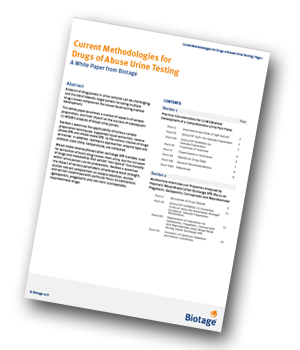Biotage has produced a white paper examining a number of aspects of sample preparation and their impact on the success of subsequent LC-MS/MS analysis of broad urine panels.
 Introduction
Introduction
Analysis of drug panels in urine samples can be challenging and the trend towards larger panels including multiple drug classes compounds the issues faced during method development.
Section 1 examines the applicability of various sample preparation techniques: supported liquid extraction, reverse-phase SPE and mixed-mode SPE, to the various classes of drugs extracted. In addition, hydrolysis approaches: enzyme type and protocol used (time, temperature), are compared. Mixed-mode reverse phase/cation exchange SPE is widely used for extraction of basic drug classes from urine, but the inclusion of drugs and metabolites that exhibit ‘non-typical’ functionality within urine panels can be problematic.
Section 2 examines the impact of various parameters (interference wash strength, elution solvent composition) on analyte retention, elution and extract cleanliness with particular focus on zwitterionic (gabapentin, pregabalin) and non-ionic (carisoprodol, meprobamate) drugs.
Hydrolysis Evaluation Procedure
Three beta-glucuronidase enzymes were evaluated: Red abalone (BG100, Kura Biotec, Los Angeles, CA), abalone (Campbell Scientific, Rockford, IL), and recombinant (IMCSzyme, Irmo, SC); to determine which provided the most complete hydrolysis of glucuronide metabolites without affecting the overall recovery of non-conjugated compounds. Four glucuronides were included in a urine glucuronide control to determine the extent of hydrolysis by each enzyme: morphine-3-beta-D-glucuronide, norbuprenorphine
glucuronide, oxazepam glucuronide, and 11-nor-9-carboxy-THC glucuronide (THC-COOH) (Cerilliant, Round Rock, TX). The control was prepared so that the amount of non-conjugated drug would equal 100 ng/mL upon complete hydrolysis.
Results
Urine Hydrolysis Results
The results indicate that there was no one enzyme or incubation time/temperature that was optimal for all four glucuronides tested. The Campbell enzyme did not fully hydrolyze morphine under any conditions. Hydrolysis of THC-COOH was temperature and time dependent for all three enzymes (the degree of hydrolysis was higher at lower times and temperatures). Oxazepam was completely hydrolyzed under all conditions.
Recovery of most of the analytes in the 56 compound “free” control was consistent (within ±10%) among the three enzymes at the various times and temperatures. Carisoprodol, hydromorphone and zolpidem-phenyl-4-COOH showed some variability among different enzymes and incubation parameters.




